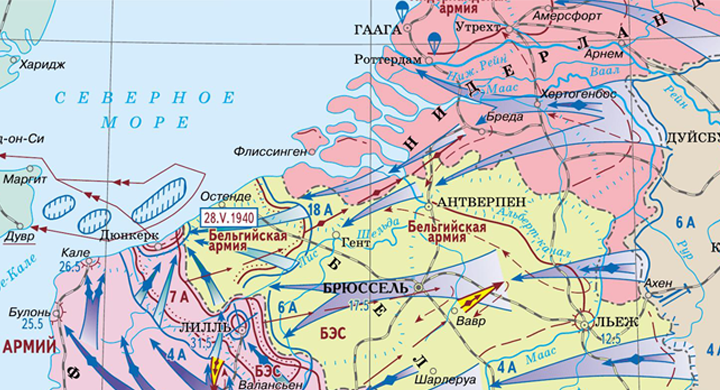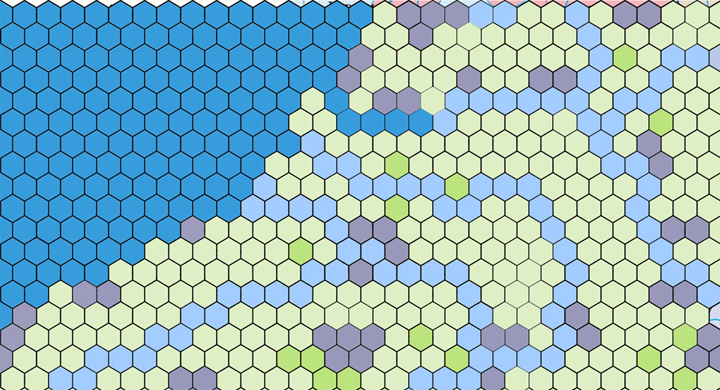How we create levels
From the very beginning we set a goal - to give the player the most realistic feeling of military leadership on the battlefields of World War II. It is hardly possible if the Theatre of military operations corresponds a little to the original in the game.
Eugene Sobolev, our game- designer, tells you about the process of creating levels in Panzer Strategy: Blitzkrieg:
Having started my work on the game, I found out that I knew a little about the Second World War. A set of key war events and dates is well-known for us: the seizure of Poland, Norway, France by the Third Reich. But do all of us know why Poland was bound to suffer a defeat from the very beginning of the German invasion, why during the invasion of France in 1940 the German Command undertook the offensive of tank forces across the mountain-forested terrain of the Ardennes or what difficulties the Luftwaffe had during the battle of Britain.
When I faced the challenge of creating game levels, I simply took the detailed Atlas of World War II Military Operations showing the locations of cities, water barriers, railway tracks, airdromes and ports. You cannot invent anything better for the design of historical strategy missions.

And now I’ll tell you about the process of creating a game level using the example of the Wehrmacht’s invasion of France in 1940.
In April1940 the Third Reich troops are known to have launched an offensive on the territory of France across Holland, Belgium and Luxemburg.
The armies of Belgium and Holland yielded significantly to the Wehrmacht but the territories of these countries could not be called convenient for the offensive: a great number of canals and fortifications including the mighty artillery Fort of that time Eben-Emael blocked the way for the Germans. I came to the conclusion that the picture of the German offensive would be incomplete. As a result, the part of Holland known as Fortress Holland, Belgium and Luxemburg occupy the north-east of the map. Paris occupies the north-eastern boundary of the map. After its fall the issue of France’s defeat in the war could be considered to be closed., so there is no sense in extending the map to the south and east of the French capital. Now when the boundaries of the theatre of military operations are marked, it is time to work on the terrain. First, I put a hexagonal mesh on the map. The mesh size can be different, depending on how big we want to make the game map. In this particular case,30x37 hexes are quite playable: it allows to place all the things needed, but not to overload the player with more than necessary turns.
Secondly, we mark out the terrain. We must make it clear what type of terrain every hex (the city, the plain, the river, the ocean and so on) belongs to. Along with this the atlas gives an immense advantage in reproducing to high precision the configuration of a sea shore, rivers, railway tracks, the location of the main cities such as Paris, Brussels, Amsterdam and so on. Of course, the cities themselves are much bigger than on the real terrain, but in this case, it is efficient due to the hex scale. The location of populated places in relation to each other remains the same as in reality.
Finally, I map the Ardennes. It is the only mountainous terrain on the given level. Unfortunately, there is no relief description on the combat chart, that is why, I have to use a physical map for the relatively precise localization of the Ardennes.

So what actually waits for us in France? The terrain filled with water barriers: the Rhein, then the Maas, the Albert Canal and The Marne-and all these barriers are combined with various fortifications. Frankly speaking, I don’t envy the Wehrmacht soldiers who must force a crossing over all these water barriers under the fire from the Belgian and Dutch forts. Besides, the French troops, deployed on the Maginot Line, are waiting for them beyond the Maas.
By the way, a few words must be said about the location of fortifications and other military objectives.
In general. here I also try to follow the schemes and descriptions of really existed lines of defence. For example, the Maginot Line, Fort Eben-Emael and the other objectives are situated roughly in the same places where they were really situated (moreover, there is a heavy artillery command post in Eben-Emael).
And also in the game, as in reality, the Germans have an alternative way for their offensive. It is the mountain mass of the Ardennes. It is the extremely inconvenient terrain for tank moving, but exactly across this terrain the German tank units went round the Maginot Line from the south so unexpectedly for the Allies. You can try to do the same.
While locating the troops, I take into account the real correlation of forces and the structure of fighting armies. In this case, the Germans have strong tank troops, aviation forces and parachute jumpers. The last will be especially useful for you in Belgium and Holland.
And what do the Allies have? The armies of Holland, Belgium and Luxemburg are small in number and not rich in armoured vehicles, but the French army has a sufficient amount of tanks and aircraft. So, the Germans are unlikely to succeed in conquering it by simple numerical superiority.
In the northern part of France, I have located the British expeditionary corps. As soon as the affairs of Allies go backward, the corps will begin a hasty retreat towards Dunkirk. In the given mission, I have made the hexes around it inaccessible for moving. Why? In the game the battle of Dunkirk is carried out by a certain mission and it will be extremely illogical, if the player assaults it twice.
Here you will, maybe, put a logical question: how will the British get to know where it is necessary to retreat? On our levels the system of triggers has been realized. In the game the certain events can be triggered after the certain conditions set in, for example, the seizure of some points. In the case of France, the level is conceived so, that from the very moment when the front of the Allies starts to break down, their units will turn into a stampede. Why will it happen? Play, and you will see everything on your own!
In my opinion, the level, devoted to the invasion of France, turns out to be historically established and rather interesting from the tactical point of view. While passing it, the player has a choice, whether to follow the historical course of events or try to realize your own unique strategy.
In a similar vein, we prepare the other missions of Panzer Strategy: Blitzkrieg. Of course, under this approach the level-design requires much time and efforts, but the goal is worth it. In fact, we want to impart our users the unique experience of commanding the troops and the highest possible feeling of the realism of what is going on.